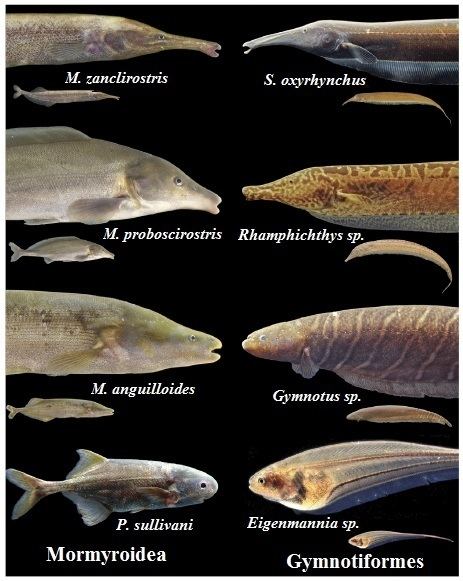Scientific name Gymnotiformes Rank Order | ||
 | ||
Lower classifications Ghost knifefish, Apteronotus | ||
Gymnotiformes
The Gymnotiformes are a group of teleost bony fishes commonly known as the Neotropical or South American knifefish. They have long bodies and swim using undulations of their elongated anal fin. Found exclusively in fresh water, these mostly nocturnal fish are capable of producing electric fields for navigation, communication, and, in the case of the electric eel (Electrophorus electricus), attack and defense. A few species are familiar to the aquarium trade, such as the black ghost knifefish (Apteronotus albifrons), the glass knifefish (Eigenmannia virescens), and the banded knifefish (Gymnotus carapo).
Contents
- Gymnotiformes
- hd dark tank with a black ghost knifefish wei stirn messerfisch tierpark bochum 14 26
- Description
- Taxonomy
- Distribution and habitat
- Evolution
- References
hd dark tank with a black ghost knifefish wei stirn messerfisch tierpark bochum 14 26
Description

Aside from the electric eel (Electrophorus electricus), Gymnotiformes are slender fish with narrow bodies and tapering tails, hence the common name of "knifefishes". They have neither pelvic fins nor dorsal fins, but do possess greatly elongated anal fins that stretch along almost the entire underside of their bodies. The fish swim by rippling this fin, keeping their bodies rigid. This means of propulsion allows them to move backwards as easily as they move forward.
The caudal fin is absent, or in the apteronotids, greatly reduced. The gill opening is restricted. The anal opening is under the head or the pectoral fins.

These fish possess electric organs that allow them to produce electricity. In most gymnotiforms, the electric organs are derived from muscle cells. However, adult apteronotids are one exception, as theirs are derived from nerve cells (spinal electromotor neurons). In gymnotiforms, the electric organ discharge may be continuous or pulsed. If continuous, it is generated day and night throughout the entire life of the individual. Certain aspects of the electric signal are unique to each species, especially a combination of the pulse waveform, duration, amplitude, phase and frequency.
The electric organs of most Gymnotiformes produce tiny discharges of just a few millivolts, far too weak to cause any harm to other fish. Instead, they are used to help navigate the environment, including locating the bottom-dwelling invertebrates that compose their diets. They may also be used to send signals between fish of the same species. In addition to this low-level field, the electric eel also has the capability to produce much more powerful discharges to stun prey.
Taxonomy
There are currently 225 valid gymnotiform species in 34 genera and five families, with many additional species known but yet to be formally described. The actual number of species in the wild is unknown. Gymnotiformes is thought to be the sister group to the Siluriformes from which they diverged in the Cretaceous period (about 120 million years ago).
The families are classified over suborders and superfamilies as below.
Order Gymnotiformes
Suborder GymnotoideiSuborder SternopygoideiSuperfamily RhamphichthyoideaFamily Rhamphichthyidae (sand knifefishes)Family Hypopomidae (bluntnose knifefishes)Superfamily ApteronotoideaFamily Sternopygidae (glass and rat-tail knifefishes)Family Apteronotidae (ghost knifefishes)Distribution and habitat
Gymnotiform fishes inhabit freshwater rivers and streams throughout the humid Neotropics, ranging from Guatemala to northern Argentina. They are nocturnal fishes. The families Gymnotidae and Hypopomidae are most diverse (numbers of species) and abundant (numbers of individuals) in small nonfloodplain streams and rivers, and in floodplain "floating meadows" of aquatic macrophytes (e.g., Eichornium, the Amazonian water hyacinth). Apteronotidae and Sternopygidae are most diverse and abundant in large rivers. Species of Rhamphichthyidae are moderately diverse in all these habitat types.
Evolution
Gymnotiformes are among the more derived members of Ostariophysi, a lineage of primary freshwater fishes. The only known fossils are from the Miocene about 7 million years ago (Mya) of Bolivia.
Gymnotiformes has no extant species in Africa. This may be because they did not spread into Africa before South America and Africa split, or it may be that they were out-competed by Mormyridae, which are similar in that they also use electrolocation.
Gymnotiformes and Mormyridae have developed their electric organs and electrosensory systems (ESSs) through convergent evolution. As Arnegard et al. (2005) and Albert and Crampton (2005) show, their last common ancestor was roughly 140 to 208 Mya, and at this time they did not possess ESSs. Each species of Mormyrus (family: Mormyridae) and Gymnotus (family: Gymnotidae) have evolved a completely unique waveform that allows the individual fish to identify between species, genders, individuals and even between mates with better fitness levels. The differences include the direction of the initial phase of the wave (positive or negative, which correlates to the direction of the current through the electrocytes in the electric organ), the amplitude of the wave, the frequency of the wave, and the number of phases of the wave.
One significant force driving this evolution is predation. The most common predators of Gymnotiformes include the closely related Siluriformes (catfish), as well as predation within families (E. electricus is one of the largest predators of Gymnotus). These predators sense electric fields, but only at low frequencies, thus certain species of Gymnotiformes, such as those in Gymnotus, have shifted the frequency of their signals so they can be effectively invisible.
Sexual selection is another driving force with an unusual influence, in that females exhibit preference for males with low-frequency signals (which are energetically expensive and easily detected by predators), but most males exhibit this frequency only intermittently. They also prefer males with longer pulses, also energetically expensive, and large tail lengths. These signs indicate some ability to exploit resources, thus indicating better lifetime reproductive success.
